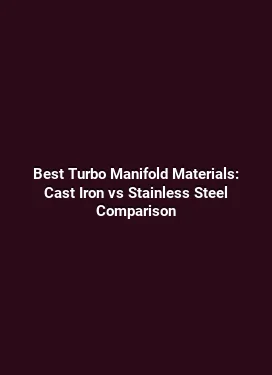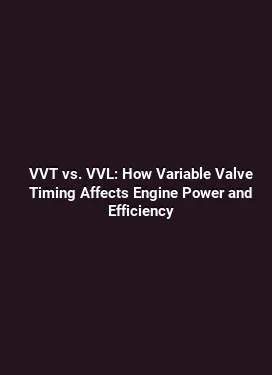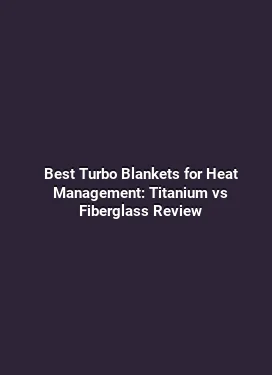Turbo Oil Feed and Return Line Sizing Guide for Custom Installations
In high-performance engine builds, the reliability of the turbocharging system hinges on the integrity of the oil delivery and return paths. Correctly sized oil feed and return lines ensure consistent oil pressure at the turbo wheel, effective cooling, and proper sealing of the bearing housing. This guide walks through the essential considerations, practical sizing methods, material choices, and installation practices that help technicians and enthusiasts achieve durable, repeatable results in custom applications.
Fundamental Purpose of Oil Feed and Return Lines

Oil feed lines supply pressurized lubrication oil from the engine’s scavenged oil system to the turbocharger bearing housing. The feed path must maintain adequate pressure at the turbine’s bearing to prevent wear and to minimize oil caviation, especially under high boost and RPM conditions. The return line, conversely, returns used oil from the turbo’s center section back to the engine sump. A well-designed return path prevents oil pooling in the turbo, reduces backpressure, and supports a stable oil temperature profile.
Both lines operate within the broader lubrication system and are influenced by engine oil temperature, overall oil pressure, and the dynamic demands created by boost pressure and engine load. The sizing decisions are not simply about inner diameter; they involve routing, bend radii, fluid velocity targets, and the interplay with fittings and adapters that minimize restrictions and potential leaks.
Key Variables That Drive Sizing Decisions
Several core factors determine the appropriate dimensions and routing for feed and return lines in a custom turbo setup. The following elements should be evaluated together to produce a robust design:
Oil Pressure at the Turbo Inlet

Feed line sizing must ensure sufficient pressure at the turbo’s bearing housing across the full operating map, including high-RPM, high-boost scenarios. In practice, this means accounting for the engine’s oil pressure curve, line losses due to length and bends, and the pressure drop introduced by any restrictive fittings. A miscalculated loss can reduce bearing lube margins, especially when oil temperature rises and viscosity drops.
Oil Temperature and Viscosity
Oil temperature directly affects viscosity and flow velocity. Higher temperatures thin the oil, increasing the risk of cavitation and inadequate cooling if the line is undersized. Conversely, an oversized line may reduce pump head pressure unnecessarily and complicate routing. The objective is to maintain an optimal flow rate that keeps oil within a target temperature band during sustained boost and high-load operation.
Oil Feed Line Sizing: Practical Guidelines
The feed line must deliver a steady, non-turbulent flow to the turbo. Excessive velocity can generate foaming and aeration, while insufficient velocity can lead to stagnant pockets near the bearing. Practical sizing involves selecting a core diameter that achieves the needed volumetric flow without excessive pressure drop. A common approach is to start with manufacturer-recommended minimums as a baseline, then adjust for the specifics of the custom install.
Typical feed line practices include using a high-quality steel, stainless steel, or AN-style silicone line with compatible fittings. A routed path that minimizes sharp bends reduces pressure losses and avoids snagging near heat sources or moving components. It is also important to consider the line’s routing relative to exhaust heat, not allowing an oil line to sit directly over hot components without adequate shielding.
Line Diameter and Flow Considerations
In many turbo systems, the feed line is sized in conjunction with the turbo’s internal flow path. For engines in the 400–700 HP range, a common starting point is a 1/4 inch (approximately 6.35 mm) to 3/8 inch (approximately 9.5 mm) line for the initial feed, with attention paid to length and fittings that can introduce pressure drop. For larger turbochargers and higher horsepower targets, a 1/2 inch (12.7 mm) line may be warranted. The exact dimension should be verified with flow analysis that accounts for oil temperature, engine oil pressure, and the turbo’s internal bearing clearances.
Fittings, Adapters, and Sealing
Fittings should be compatible with the chosen line material and capable of withstanding engine oil pressures at peak boost. The use of high-quality, corrosion-resistant fittings with proper hardness and sealing surfaces reduces the risk of leaks. Ensure that threads and sealing surfaces are clean and protected during assembly to avoid contamination. The use of pre-made, purpose-built oil feed assemblies can simplify installation while maintaining reliability.
Oil Return Line Sizing: Ensuring a Clean Return Path
The return path must accommodate the flow of the used oil from the turbo back to the sump without forming reservoirs or creating a siphon effect that could starve the turbo of lubrication. Return line sizing is heavily influenced by the turbo’s internal oil control strategy, the crankcase ventilation system, and the routing that minimizes backpressure in the return path.
A poorly sized or poorly routed return line can accumulate oil, causing backpressure against the turbo and potentially pushing hot oil into the turbine housing. This not only reduces efficiency but also elevates thermal stress on the bearing housing and seals. Proper return line diameter, combined with a gravity-assisted routing (where possible) and a generous slope, helps maintain a self-draining system even during dynamic driving conditions.
Return Line Diameter and Gravity-Assisted Flow
Return line dimensions must accommodate the maximum expected oil flow out of the turbo during periods of high boost and engine load. Depending on the setup, a 1/2 inch (12.7 mm) ID line is a common choice for high-output applications, while smaller builds may perform adequately with 3/8 inch (9.5 mm). The key is to ensure the line remains full of liquid with a clear, unobstructed path to the oil pan, avoiding pockets that can trap air or oil. A gentle downward slope toward the sump is essential for consistent gravity-driven return flow.
Drain Back to the Sump and Contamination Control
Return lines must feed into a clean oil reservoir point, ideally returning to a location that has minimal turbulence and where debris can be filtered by the engine’s oil pickup screen. It is common to route the return to a lower point on the oil pan or to a dedicated scavenging port that aligns with the crankcase ventilation strategy. The return path should be protected from heat, vibration, and potential impact from the exhaust system or other hot components.
Material Selection and Durability Considerations
Material choice for both feed and return lines impacts lifecycle, temperature resistance, and compatibility with engine oil. Common options include stainless steel braided lines, corrosion-resistant steel tubing, and high-quality reinforced hoses with appropriate temperature ratings. The interior surface finish should resist oil-wicking and keep a smooth bore to minimize flow disturbances. For custom installations, using lines with flex sections near the engine block can accommodate movement and engine flex without imposing stress on the connections.
Heat shielding is another critical factor. In proximity to exhaust components or turbochargers, insulation sleeves or reflective wraps help maintain oil temperature within desired ranges and protect lines from heat-induced damage. The combination of robust materials and protective shielding contributes to a longer service life, especially in track or off-road environments where vibrations and temperature swings are more pronounced.
Routing Best Practices for Consistency and Reliability
A well-planned routing strategy reduces the probability of leaks, kinks, or abrasion over time. Consider these practical guidelines when planning the layout:
- Keep feed and return paths separate as much as possible to prevent cross-contamination and simplify inspection.
- Avoid routing lines near high-heat zones, moving parts, or sharp edges that can abrade the line over time.
- Use smooth bends with generous radii to minimize pressure loss and reduce stress at fittings.
- Secure lines with non-conductive clamps to avoid vibrational wear and to prevent metal-to-metal contact with other components.
- Incorporate service-friendly access points for inspection and potential line replacement without full disassembly.
During installation, ensure that all connections are torqued to the manufacturer’s specifications and that seals are correctly seated. After assembly, perform a leak check at both the feed and return fittings, ideally with the engine off and the oil at normal operating temperature when pressure testing to ensure there are no hidden leaks under service conditions.
Validation: How to Verify Sizing in Real-World Conditions
Validation involves confirming that the turbo receives adequate lubrication at all expected operating points and that the return path clears oil back to the sump without delay. Practical verification steps include:
- Monitor oil pressure at the turbo inlet under pull-up and boost conditions to ensure there is no excessive drop compared to the engine’s baseline oil pressure.
- Measure oil temperature at the sump and near the turbo to confirm that heat transfer remains within acceptable ranges for the chosen oil grade.
- Perform a controlled dyno session with monitoring of oil drain back times and note any oil pooling in the return line during high-RPM runs.
- Inspect fittings and line interiors after a track day or high-stress session for signs of wear, vibration, or heat damage.
- Use a dye or clear line segment temporarily to visualize flow direction and identify potential trapped pockets during initial testing.
Iterative adjustments may be necessary in custom installations. Small changes in line diameter, bend radii, or routing can yield smoother oil flow and improved bearing life under extreme conditions. Documentation of the changes and observed performance helps build a repeatable process for future builds or maintenance cycles.
Common Pitfalls to Avoid
Several frequent mistakes can undermine the durability of turbo oil lines. Being aware of these pitfalls helps ensure a more reliable installation:
- Undersized feed lines that experience voltage drop in high-boost scenarios, leading to oil starvation at the bearing.
- Return lines with insufficient diameter or poor routing that trap air or create backpressure during oil drainage.
- Routing lines over exhaust manifolds or near hot turrets without adequate insulation.
- Incompatible fittings or mismatched thread types that cause fastener failure or leaks.
- Neglecting to check line support and securement, leading to vibrations that eventually loosen connections.
Illustrative Example: A Practical Sizing Scenario
Consider a turbocharged V8 build producing approximately 650 horsepower with a reasonably aggressive boost target. The engine’s oil pressure at idle is around 45 psi, rising to approximately 70–90 psi under boost. For safety, the feed line should maintain at least 10–15 psi of margin at the turbo inlet during peak demand, and the return line should be sized to allow quick drainage back to the pan without creating a flood-back scenario.
Starting with a 1/4 inch feed line, a designer notices a measurable pressure drop at the turbo inlet during a high-RPM pull. To compensate, the line diameter is increased to 3/8 inch, and the length is shortened by routing changes. The final path uses smooth bends with a minimum bend radius and stainless steel braided hose where appropriate. The return line is upgraded from 3/8 inch to 1/2 inch, with a slight downward slope toward the sump and a protected route away from heat sources. After installation, a dyno test confirms that the oil pressure at the turbo inlet remains within the target window across the operating map, and oil drain back is consistently rapid without pooling.
Such adjustments illustrate how real-world observations guide sizing decisions. Each build presents a unique combination of engine displacement, turbo size, oil type, and operating environment, so documenting measurements and outcomes supports better future decisions.
Conclusion-Worthy Takeaways for Custom Installations
While this guide emphasizes the specifics of feed and return line sizing, the overarching principle is to harmonize lubrication flow with the turbo’s thermal and mechanical demands. Selecting line materials, diameters, and routing paths that minimize pressure losses, avoid heat exposure, and permit reliable drainage is essential for a robust turbo system. A meticulous approach—grounded in actual operating data and validated through testing—yields durable performance and predictable results across a wide range of driving conditions.






